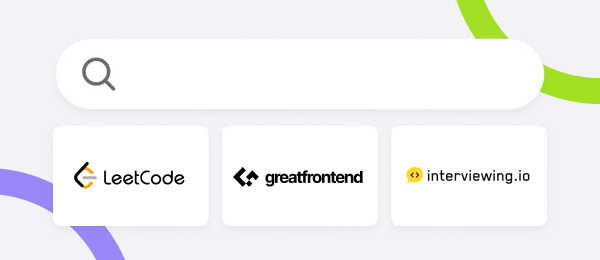Generative AI is Redefining the Way We Work, Plan, and Innovate
Generative AI is becoming your go-to assistant, quickly generating reports for you, summarizing your meetings, and answering practically any question in seconds. It has rapidly become one of the most powerful technologies adopted worldwide, making tasks simpler, faster, and reshaping the way we work, strategize, and innovate.
Let’s explore how generative AI is automating repetitive tasks, streamlining communication, reshaping roles, and ultimately transforming workplaces.
Understanding Generative AI in the Workplace
Generative AI development company can produce new content, like text, images, audio, or video, by learning from vast datasets. In response to user prompts, it generates outputs that often mimic human-like creativity and communication.
When we talk specifically about generative AI in the workplace, we’re referring to AI development services that helps employees and businesses become more productive by automating repetitive tasks and helping them communicate clearly and efficiently.
Real-World Examples of Generative AI in the Workplace
Generative AI is not only transforming high-level business strategy, but it’s also reshaping the everyday tasks that keep workplaces running efficiently, including creative tools like an AI art generator.
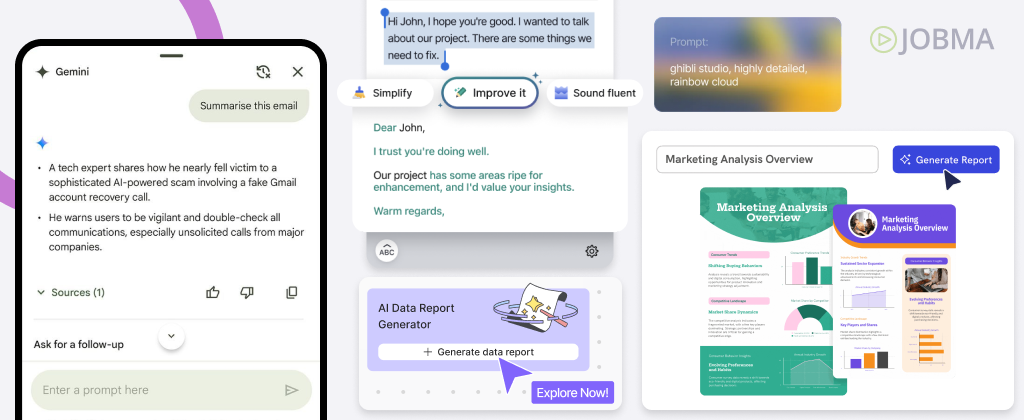
From automating repetitive chores to powering advanced communication and content creation, here’s how it’s making an impact:
- Data Entry and Management: AI systems can now input, organize, and analyze large volumes of structured and unstructured data, cutting down hours of manual work and boosting accuracy in records, financials, and operations. An app connector can help link these AI tools with existing platforms to ensure data flows smoothly between systems.
- Scheduling and Administrative Tasks: Tools like Microsoft 365 Copilot, Google Assistant, and Apple Intelligence automate calendar management, send meeting reminders, and streamline internal workflows to reduce cognitive load.
- Quality Assurance: Whether reviewing legal documents, scanning code for bugs, or flagging policy inconsistencies, AI tools help maintain high standards while minimizing human oversight fatigue.
- Automated Report Writing: Platforms like Microsoft Copilot and ChatGPT can analyze large datasets, highlight key insights, and produce easy-to-read reports, such as sales performance summaries, project updates, customer feedback analyses, and financial overviews, freeing employees from hours of manual work.
- Email Management: Tools such as Gmail’s Gemini assistant or Outlook’s AI-powered features understand the context of incoming messages and suggest polished, concise replies for faster inbox management.
- Meeting Summaries: Apps like Otter.ai, Notion AI, and Zoom AI Companion automatically summarize long meetings and extract action items, saving teams the effort of note-taking.
- Content Creation: Marketing teams use tools like WeShop AI, Jasper, Copy.ai, and ChatGPT for sales to generate social media posts, blog drafts, and even detailed product descriptions with speed and consistency. Designers and marketers also use AI platforms to generate AI images for ads, presentations, and websites—saving time on sourcing stock imagery or hiring illustrators.
- AI video platforms like VEED, Synthesia, Vidu AI, and Pictory are now enabling teams to create professional-quality marketing videos, training materials, and product demos in minutes – complete with realistic avatars and voiceovers – eliminating the need for expensive production crews.
- Virtual Assistants: AI-driven helpers like Apple Intelligence on Mac, Google Assistant, Microsoft 365 Copilot, and Agentic AI chat agents and AI Voice Agents assist with scheduling, calendar management, and quick responses to common questions, acting as on-demand productivity partners. an AI voice generator can further enhance these interactions by providing natural-sounding voice responses for customer service calls, voicemails, and other audio-based communications.
Generative AI Use Cases for Businesses
Let’s look at specific areas where it’s making a noticeable difference. The result is a continuously updated, comprehensive view of your talent landscape.
1. Hiring and Recruitment
The hiring process traditionally involves sorting through hundreds of resumes, screening candidates, and conducting interviews, a time-consuming task. Generative AI simplifies HR through tools such as:
- Candidate Screening Software: AI-powered systems automatically analyze resumes and filter candidates based on specific job requirements. Asynchronous interviews allow candidates to record their responses at any time, offering greater flexibility for both applicants and recruiters. This not only accelerates initial screening but gives recruiters a more holistic view early in the process, helping reduce bias and streamline shortlisting.
- Interview Management System: Generative AI can help create custom interview questions and evaluate candidate responses. Some companies use platforms that analyze recorded video interviews, identifying candidates who best match the job criteria.
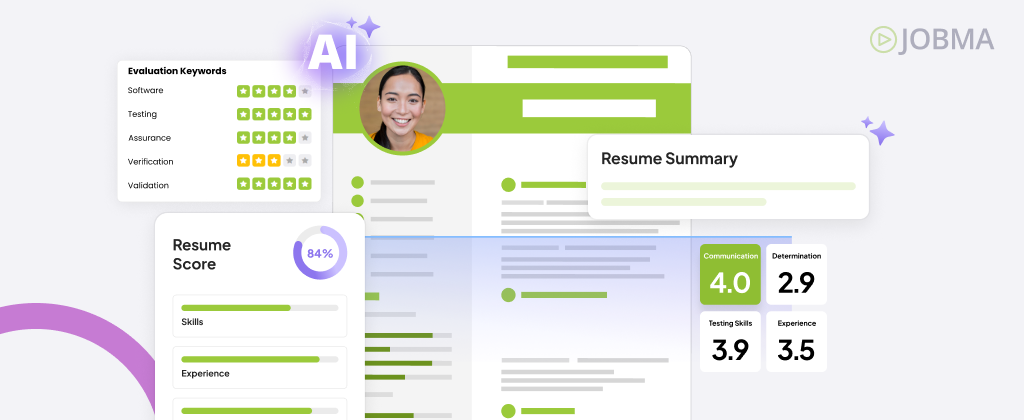
Platforms like Jobma use AI to streamline candidate screening through asynchronous video interviews. Recruiters send preset interview questions, and candidates record their responses at their convenience. AI then assists recruiters in analyzing these responses to quickly spot the best talent.
2. AI for Smarter Customer Engagement
Generative AI enhances customer engagement by handling routine interactions, like answering FAQs, providing real-time status updates, and guiding users through basic troubleshooting. These tools help address common queries instantly, ensuring customers get timely information while human support teams focus on more complex or personalized assistance. A reliable answering service, leveraging AI, can provide 24/7 support, reduce wait times, and deliver personalized experiences across chat, email, and voice, often powered by AI Phone Calls.
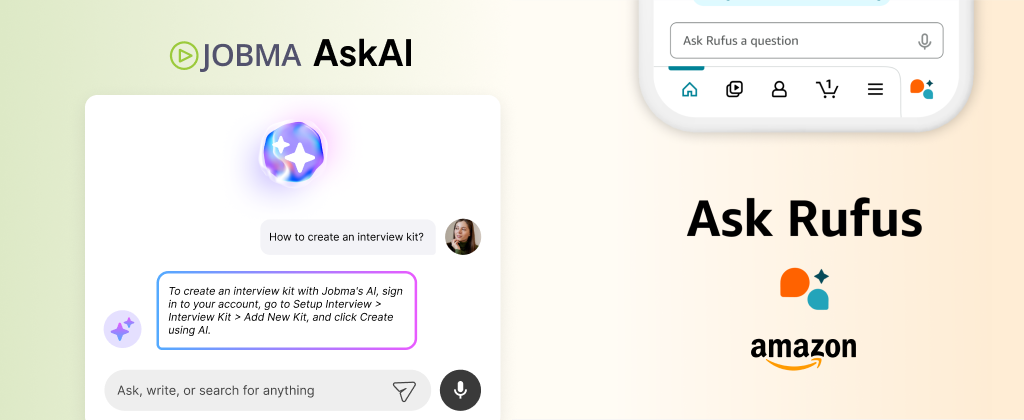
Example: Platforms like Shopify and Amazon link generator, such as Amazon’s Rufus, to guide customers, boosting responsiveness while keeping human agents available for deeper support. Many businesses also collaborate with a trusted Shopify Agency to optimize their storefronts and customer experiences alongside AI-driven engagement tools.
3. Marketing and Content Creation
Generative AI has become a game-changer in digital marketing, empowering teams to produce high-quality content at scale, whether it’s drafting blog outlines, campaign copy, or SEO-optimized product descriptions. It can also speed up processes such as niche edits by suggesting precise, relevant updates to existing content. Many professionals also use an AI SEO Agent to streamline tasks like keyword research, content structure optimization, and local SEO – enhancing overall performance. Beyond content and SEO, getting your brand noticed often means building strong connections and getting media coverage. To truly get noticed, businesses also rely on digital PR services to expand their reach and build stronger brand awareness. AI is also redefining how SEO strategies are executed. With smart tools and SEO Reseller platforms now integrating AI features, businesses can automate keyword research, backlink analysis, and on-page optimization more efficiently. These advancements help brands Boost SEO performance, improve visibility, and stay ahead in competitive search results.
Major global brands are embracing this shift: Coca-Cola’s “Create Real Magic” invited audiences to co-create content using AI tools; Heinz’s “AI Ketchup” campaign used DALL·E to generate playful product visuals; and Nike celebrated Serena Williams with an AI-simulated match spanning her career.
Brands like Spotify and Netflix use generative AI to personalize promotional assets, while Nutella created millions of unique jar designs using an AI algorithm in conjunction with HP’s SmartStream Designer (now part of the PrintOS Creativity Power Pack). Going one step further, beyond written and visual content, AI is also beginning to reshape influencer marketing. Virtual AI influencers are emerging as powerful brand ambassadors, blending creativity, scalability, and authenticity in new ways.
These campaigns highlight how AI is no longer just a tool but a creative partner driving speed, personalization, and innovation in marketing, To take things a step further, pairing AI with tools that extract a color palette from image sources enhances visual consistency, enabling brands to create cohesive and eye-catching campaigns that align with their identity. This combination streamlines design processes while maintaining strong brand aesthetics.
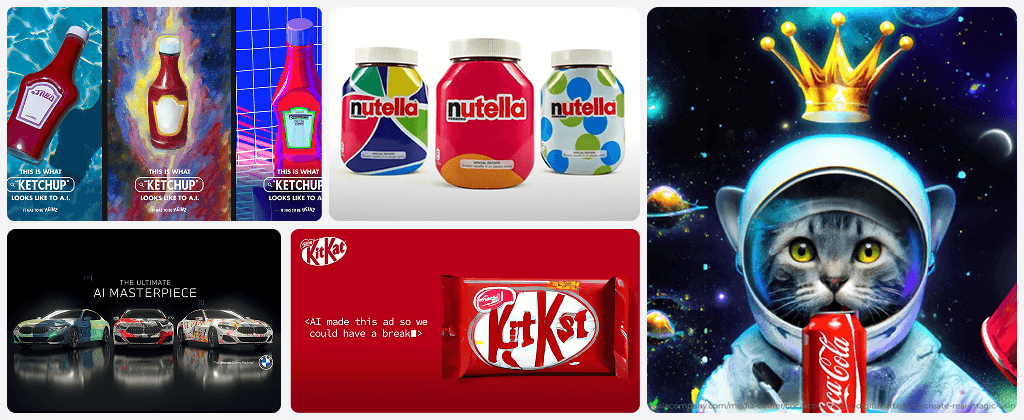
By automating repetitive writing tasks, teams can redirect their energy toward brand strategy, audience insights, and creative experimentation.
Example: Tools like Jasper, Copy.ai, and ChatGPT assist in creating tailored marketing assets in minutes, helping brands stay consistent across channels while adapting quickly to trends and audience feedback.
How Generative AI is Changing Workplace Communication
Communication is essential in every workplace. Generative AI is transforming how employees communicate both internally (within teams) and externally (with clients and customers).
- Simplifying Internal Communication: Tools like 1up’s Sales Enablement Automation take this a step further by serving as an instant knowledge base. Instead of pinging teammates or waiting on replies, employees can ask 1up any question and get accurate, real-time answers drawn directly from company knowledge. This frees teams from repetitive interruptions and keeps everyone focused on higher-value work. Similarly, an AI service desk can enhance this process by automatically handling routine support requests and ensuring employees always have quick access to the help they need.
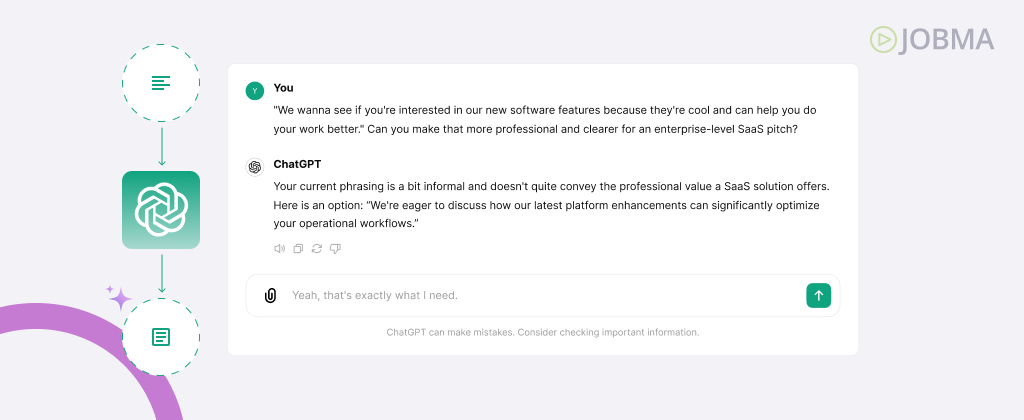
- Streamlining External Communication: Generative AI platforms such as ChatGPT, Jasper, and Zoho SalesIQ assist in crafting personalized emails, proposals, and stakeholder messages. These tools help businesses respond faster, maintain brand voice, and build stronger relationships with customers and partners.
- To further enhance proposal workflows, AI RFP technology automates the complex task of responding to detailed requests, enabling teams to deliver accurate and consistent answers more efficiently.
- Enhancing Remote Work: Tools like Otter.ai, Krisp Ai, Notion AI, and Google Meet’s AI features support remote teams by translating conversations in real time, summarizing meetings, and generating action items, keeping everyone aligned regardless of time zone or location.
- For group scheduling across distributed teams, tools like WhenAvailable — a simple, poll-based Doodle alternative can make it easier to coordinate meeting times without endless back-and-forth.
Empowering Employees through Gen AI
Generative AI is changing the fabric of modern work, not by replacing jobs, but by redefining how employees spend their time and energy. Rather than focusing on manual, repetitive tasks, workers are now empowered to tackle higher-impact responsibilities that require creativity, strategy, and decision-making.
Shifting Workloads and Empowering Talent
Reducing Repetitive Tasks: With AI handling time-consuming chores like data entry, scheduling, and document formatting, employees can redirect their efforts toward problem-solving, planning, and innovation.
New Skill Requirements: The rise of AI calls for a fresh skillset, one where employees learn to collaborate with smart systems, critically assess AI-generated outputs, and apply emotional intelligence to human-centric tasks.
Better Decision-Making: AI tools provide access to deep analytics and data-backed insights, enabling faster and more confident decisions across roles and departments.
Elevating the Employee Experience
Increased Efficiency: Tasks are completed faster and more accurately, relieving stress and enhancing job satisfaction.
Enhanced Creativity: With less time spent on repetitive work, employees have more bandwidth for strategic thinking and creative execution.
Better Work-Life Balance: Automating routine workflows reduces time pressure and allows for more manageable schedules, supporting healthier boundaries between personal and professional life.
Continuous Learning Opportunities: As AI becomes part of daily workflows, employees are encouraged to upskill, explore new tools, and evolve professionally, opening doors to better career growth.
Future of Generative AI in the Workplace
Generative AI is already embedded in today’s workflows, transforming how businesses operate and how employees contribute. AI on the future of work is not just about automation, but about transforming how people collaborate, innovate, and create value together. Many organizations are now relying on generative AI development services to tailor these tools to specific operational workflows and industry needs. Its adoption has helped automate repetitive tasks, enhance communication, and deliver real-time insights, making it a powerful asset across industries.
Looking ahead, its role in the workplace will only grow. Employees can work alongside AI, where they can guide outputs and apply human judgment where it matters the most. More roles will adapt to include working alongside AI systems, and organizations will increasingly invest in upskilling their workforce to make the most of these tools.
This shift brings tangible benefits: improved productivity, more creative freedom, faster decision-making, and higher job satisfaction. By thoughtfully leveraging Generative AI Integration Services in daily routines, businesses not only future-proof their operations but also empower their employees to work smarter, grow professionally, and thrive in a more fulfilling workplace.
FAQs
What is generative AI, and how is it used in the workplace?
Generative AI is a type of artificial intelligence that learns patterns from existing text, images, audio, or code and then uses those patterns to create entirely new content, such as draft articles, design mockups, chat responses, or even bits of software.
At the workplace, it’s a powerful assistant for everything from marketing and content creation (generating blog posts, social-media captions, or ad visuals in seconds) to software development (autocompleting code, finding bugs like with open source automation tools) and customer support (powering chatbots and drafting email replies).
It can also speed up data analysis by summarizing reports, help HR teams screen resumes and craft interview questions, and free up employees to focus on strategy and relationship-building rather than repetitive tasks. By handling repetitive or creative-heavy work at scale, generative AI boosts productivity and lets people spend more time on the human side of their jobs.
Which industries are using generative AI in daily operations?
Generative AI is being adopted across a wide range of industries:
- Marketing and Advertising: For content generation, campaign ideation, and personalized messaging.
- Finance: To automate compliance documentation, generate financial summaries, and detect fraud.
- Healthcare: For summarizing patient notes, generating medical imaging reports, and supporting drug discovery.
- Manufacturing: In product design, predictive maintenance, and supply chain optimization.
- Software Development: To assist with code generation, debugging, and documentation.
These are just a few examples. Gen AI is being adopted in nearly every industry.
What generative AI tools are commonly used in the workplace today?
Some of the most widely used Gen AI tools include:
- ChatGPT / Microsoft Copilot / Google Gemini: For writing, summarizing, and brainstorming.
- DALL·E and Midjourney: For generating images and visual content.
- Otter.ai and Zoom AI Companion: For meeting transcription and summarization.
- Jasper and Copy.ai: For marketing copy and content generation.
- GitHub Copilot: For code suggestions and development support.
- Zapier with AI: For automating workflows across apps.
- Qodo: Great windsurf alternative for AI code review and generation
These tools are helping teams work faster, smarter, and more creatively.
How can companies start implementing generative AI in their workflows?
Consider starting with a clear, well-defined strategy that outlines your objectives, success metrics, and a realistic timeline. Here’s how you can do that:
- Identify business goals: Focus on areas where AI can reduce friction or unlock value, such as content creation, internal communication, documentation, and customer engagement.
- Choose the right use cases: Prioritize Gen AI implementation in tasks that are repetitive, time-consuming, or data-heavy.
- Assess data readiness: Ensure you have clean, structured data to train or fine-tune models.
- Start small with pilots: Test AI in a controlled environment before scaling.
- Engage stakeholders early: Include IT, legal, and business teams to align on goals, compliance, and change management.
With plug-and-play AI platforms, organizations can embrace AI faster with less friction.

